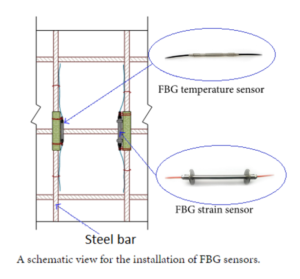Piezoelectric transducers have been traditionally used in structural health monitoring. These devices convert pressure to an electric voltage. The transducers are typically reliable in normal working conditions, however, they become less accurate in harsh environments, like high temperatures – over 300 degrees Celsius – or highly corrosive environments.
With the development of laser technologies the popularity of fiber Bragg grating sensors have been increasing due to their numerous advantages over traditional means of measuring strain, pressure, and temperature: 1) FBG sensors work reliably under very high temperatures because of the optical fiber material – fused silica; 2) fiber Bragg grating sensors are immune to electromagnetic interference; 3) the sensors are not susceptible to corrosion; 4) FBG sensors are very small and can be easily mounted on any surface. The development of fiber-optics technology will enhance structural health monitoring in harsh conditions, such as nuclear power plants and modern superheaters.
The following types of FBG sensors are used in structural health monitoring:
The main advantages of fiber Bragg grating temperature sensors are their reliability and accuracy under high temperatures, absolute temperature measurements, fast response, immunity to electric sparks. The fast response rate is particularly useful in cases where temperature shifts are extreme.
FBG sensors are the best strain sensors at the moment due to multiple advantages that are inherent to all FBG products. These sensors can determine structure parts that are stressed.
Fiber Bragg grating displacement sensors can detect shifts in structures and the appearance of cracks.
There are many applications of fiber Bragg grating sensors for structural health monitoring. For example, one of the possible uses of FBG sensors is pipeline monitoring. P19 pipelines, that are used in the power industry, are usually used to transmit corrosive high-temperature, high-pressure steam. The integrity of the pipes may deteriorate over time leading to eventual failure of the steam transmitting system.
If you would like to purchase FBG (Fiber Bragg Gratings) sensors, please contact us: info@optromix.com or +1 617 558 98 58


 Nowadays, numerous civil infrastructures have been built in metropolitan areas all over the world. The performance of these infrastructures during construction, operation, maintenance, and upgrading is a major concern for society. The use of smart
Nowadays, numerous civil infrastructures have been built in metropolitan areas all over the world. The performance of these infrastructures during construction, operation, maintenance, and upgrading is a major concern for society. The use of smart